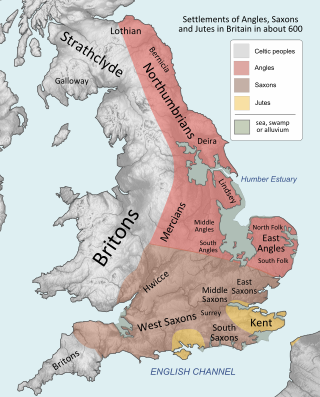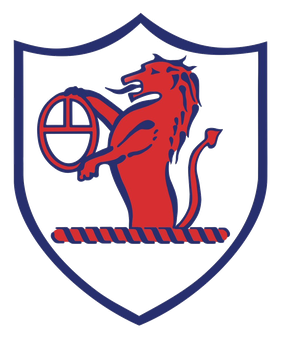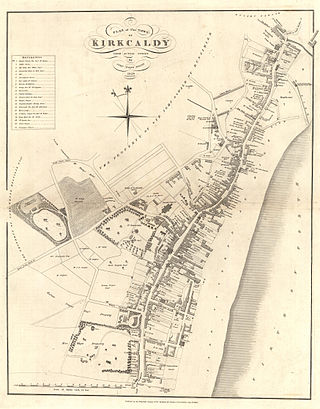Related Research Articles
The 590s decade ran from January 1, 590, to December 31, 599.

Year 596 (DXCVI) was a leap year starting on Sunday of the Julian calendar. The denomination 596 for this year has been used since the early medieval period, when the Anno Domini calendar era became the prevalent method in Europe for naming years.

Fife is a council area, historic county, registration county and lieutenancy area of Scotland. It is situated between the Firth of Tay and the Firth of Forth, with inland boundaries with Perth and Kinross and Clackmannanshire. By custom it is widely held to have been one of the major Pictish kingdoms, known as Fib, and is still commonly known as the Kingdom of Fife within Scotland. A person from Fife is known as a Fifer. In older documents the county was very occasionally known by the anglicisation Fifeshire.

Kirkcaldy is a town and former royal burgh in Fife, on the east coast of Scotland. It is about 11.6 miles (19 km) north of Edinburgh and 27.6 miles (44 km) south-southwest of Dundee. The town had a recorded population of 49,460 in 2011, making it Fife's second-largest settlement and the 11th most populous settlement in Scotland.

Raith Rovers Football Club is a Scottish professional football club based in the town of Kirkcaldy, Fife. The club was founded in 1883 and currently competes in the Scottish Championship as a member of the Scottish Professional Football League.

Y Gododdin is a medieval Welsh poem consisting of a series of elegies to the men of the Brittonic kingdom of Gododdin and its allies who, according to the conventional interpretation, died fighting the Angles of Deira and Bernicia at a place named Catraeth in about AD 600. It is traditionally ascribed to the bard Aneirin and survives only in one manuscript, the "Book of Aneirin".
Kirkcaldy High School is a 6-year co-educational comprehensive state school in Kirkcaldy, Fife, Scotland.
Shaun Dennis is a Scottish retired professional football player and coach, primarily with Raith Rovers. He was capped by Scotland at under-21 level.

Marjorie Fleming was a Scottish child writer and poet. She gained appreciation from Robert Louis Stevenson, Leslie Stephen, and possibly Walter Scott.
The Timeline of conflict in Anglo-Saxon Britain is concerned with the period of history from just before the departure of the Roman Army, in the 4th century, to just after the Norman Conquest in the 11th century.

Moelona was the pen-name of Elizabeth (Lizzie) Mary Jones, a Welsh novelist and translator who wrote novels for children and other works in Welsh.
Alexander "Sandy" Archibald was a Scottish footballer, who played for Raith Rovers, Rangers and Scotland. He was later secretary/manager of Raith and Dunfermline Athletic.

Kirkcaldy is a former royal burgh and town. Known as one of Scotland's "most ancient burghs", the area surrounding the modern town has a history dating as far back as between 2500 BC and 500 BC as a possible funerary landscape.
David W. Potter was a Scottish sports writer who published over seventy books, primarily on Scottish football and cricket.
The 1913 Scottish Cup Final was the 40th final of the Scottish Cup, Scottish football's most prestigious knockout association football competition. The match took place at Celtic Park on 12 April 1913 and was contested by Division One clubs Falkirk and Raith Rovers. It was both Falkirk's and Raith's début appearance in the Scottish Cup Final.
Bunessan is a hymn tune based on a Scottish folk melody, first associated with the Christmas carol "Child in the Manger" and later and more commonly with "Morning Has Broken". It is named after the village of Bunessan in the Ross of Mull.

Raith, as an area of Fife, once stretched from the lands of Little Raith, south of Loch Gelly, as far as Kirkcaldy and the Battle of Raith was once theorised to have been fought here in 596 AD. Raith Hill, west of Auchtertool and immediately to the east of the Mossmorran fractionation plant, may also be in reference to this wider area or may refer to an actual fort on this hill, distinct to the one naming the area.
Patrick Don Swan of Springfield FRSE DL (1808–1889) was a Scottish shipowner and shipbuilder who served as Provost of Kirkcaldy. He was a friend of Thomas Carlyle.
James Oswald was a member of the Parliament of Scotland, 1703-1707, representing Kirkcaldy and, later, the member for Dysart Burghs in the House of Commons of Great Britain.
Thomas Oswald, younger brother of James Oswald (younger) of Dunnikier, was a British Army officer in the 18th century, engaged in the War of the Austrian Succession and Seven Years' War.
References
- ↑ The Celtic Review, Vol. 6 No. 23 (January 1910) pp214-236
- ↑ "The Celtic review". Edinburgh : Macleod – via Internet Archive.
- ↑ "596 A.D. - The Battle of Raith | made by young people at Makewaves". Radiowaves.co.uk. 21 May 2009. Archived from the original on 23 December 2012. Retrieved 8 September 2012.
- ↑ "Kirkcaldy Burgh and Schyre" (1924) pp42/3 published by the Fifeshire Advertiser (Macbean was also the paper's editor).
- ↑ "Lachlan Macbean". The Canterbury Dictionary of Hymnology. Canterbury Press.
- ↑ "excerpt from Kirkcaldy Burgh and Schyre". Electricscotland.com. Retrieved 8 September 2012.